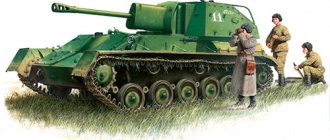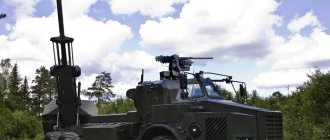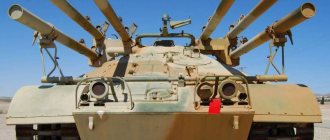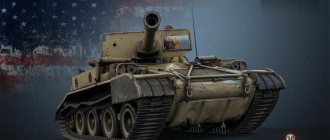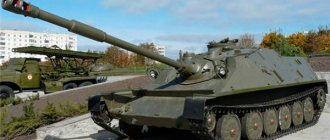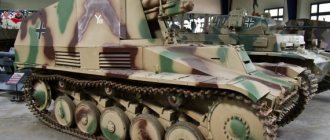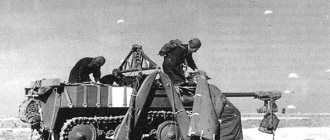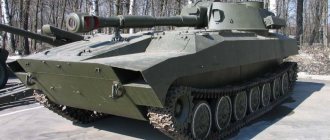A little history.
In 1942, British engineers developed a tank destroyer project based on the Valentine tank, in which they placed the famous 17-pound British anti-tank gun QF 17 pounder, capable of hitting enemy tanks even at a distance of 1000 meters. The tank was named Archer, which translated as “Archer.” The tank destroyer received an interesting feature - a rear-facing gun, which made it possible to quickly change position after an ambush attack without turning the vehicle around. The first model of the tank was released in 1943, and in 1944 Archer went into mass production. In total, there were 655 Archer self-propelled guns, which entered the artillery units of armored divisions. After production ended in 1945, the tank was in service with the Egyptian army until 1956.
Archer tank destroyer. Story
Due to the increase in armor on German tanks during the Second World War, the British Army needed more powerful vehicles. For this purpose, the designers used Valentine infantry tanks, which were equipped with 17-pounders with a caliber of 76.2 mm. The 17-pounder at that time was a universal killing weapon and could penetrate virtually any German tank, which means this weapon was an ideal choice for any anti-tank self-propelled gun.
The idea of this vehicle appeared as a replacement for the Bishop self-propelled gun with an anti-tank system. Several designs were created, but as a result it was decided that the Valentine infantry tank would be most ideal for these purposes. In addition, these tanks and components were available in large quantities in warehouses. And adapting the chassis of this tank for a 17-pounder turned out to be quite easy. Valentine was already considered as a base for a self-propelled gun in 1941, but then it was decided to use the chassis from the Crusader tank, which fully met the requirements of that time.
At the beginning of 1943, work had already begun on a new anti-tank self-propelled gun at the Valentine base. In March, several prototypes were produced with different ways of mounting the gun, both rear and front. Over the course of two months, these prototypes underwent a period of intensive testing and as a result, it was decided that the rear placement of the gun provided a tactical advantage. The tank's turret was replaced with a rigidly fixed, lightly armored welded structure with an open top. On the basis of this prototype, mass production was carried out. The self-propelled guns were equipped with the same components as the Valentines to simplify and speed up production. The latest engine from Valentine, a 6-cylinder diesel General Motors, was also used as a power plant, along with a transmission. At the same time, the gun rotation mechanism was improved, a new cooling system for the engine and new observation devices.
The order for 800 vehicles under the designation “17-pound self-propelled gun Valentine” was entrusted to Vickers-Armstrong, which began at the end of 1943, and during the first months of service these self-propelled guns became known as. the name "Archer" ("Archer").
The Archer had a low profile and therefore good camouflage, while the weapon was very powerful in order to inflict significant damage on the enemy. Its uniqueness was in the gun mounted in the rear of the hull above the engine compartment. Archer's successes were noticeable throughout the second half of the Second World War, which he spent serving in the British Royal Artillery regiment.
These self-propelled guns mainly served in Northwestern Europe in 1944, and participated in the Allied landings in Italy. Mainly ambush tactics were used, Archet could fire many rounds before being discovered, and if detected, quickly change position to continue firing from a new one.
The installation was serviced by a crew of four people: commander, driver, loader and gunner. A place with machine guns was also equipped for defense against enemy infantry and aircraft.
At the same time, the Archer tank destroyer also had its drawbacks. For example, the fact that it had very limited horizontal aiming angles, which means that in order to aim at the enemy it was necessary to turn virtually the entire body of the vehicle. Also, the open top and light armoring of the sides did not protect the crew very well. It could only resist light weapons and fragments from landmines. And besides, there was no room for the driver in the car, which means this took away precious minutes in movement after the shot, dodging the enemy’s return fire.
In May, Germany officially capitulated and the order for the Archer dropped from 800 examples to 655 vehicles, which followed global practice when many military orders were canceled or cut. However, the Archers were in service until the 50s, until they were completely decommissioned.
Archer production and characteristics:
- Manufacturer: UK
- Produced: 1944
- Produced: 655
- Crew: 4
- Total length: 6.68 m
- Width: 2.76 m
- Height: 2.25 m
- Weight: 16,257 kg
- Engine: General Motors 6-71 6-cylinder diesel engine with 192 horsepower
- Maximum speed: 32.2 km/h
- Maximum range: 225 km
Weapons:
- 1 x 76.2 mm 17-pounder gun
- 1 x 7.7 mm general purpose machine gun
General form.
At first glance, the Archer is capable of surprising - the tank has a rear-mounted gun. This style of fighting is not usual, and it takes a long time to get used to. The second feature, which follows from the first, is that Archer’s reverse speed is faster than forward. This makes the gameplay on the tank even more strange and unusual.
The main advantage of the tank is its OQF 17-pdr AT Gun Mk. VII level, which is capable of penetrating tanks that it encounters on its way, even while fighting at the bottom of the list. The gun's performance, by the numbers, is excellent - with an average alpha of 150 points, the penetration of basic AP shells is as much as 171 millimeters (!). However, this gun is not surprising - the same gun is found on a number of British vehicles, such as TOG II, FV201 (A45), Black Prince, AT 8, AT 15 and so on. The alpha strike for the gun, as for the 5th level, is very acceptable - 150 points. Yes, at level 7 with such damage it already becomes ridiculous, but at level 5 it’s just “just right.” As for the exact characteristics of the guns, it’s just the opposite - compared to vehicles of higher levels, here the gun takes longer to reload, aim, and has spread. The gun reload time is 4.6 seconds, and with this indicator the DPM per minute is equal to 1916 points. The spread at 100 meters is 0.3, and the convergence is 2.3 seconds.
Click and read: UDES 16
With a specific power of the vehicle of 10.39 liters, the maximum speed of the tank is low (and let us remember once again that the reverse speed is faster than the forward one) - only 12 km/h forward and 32 km/h reverse. That is, we run away on the “Archer” backwards, shooting back from our opponents.
We don’t remember about reservations here - all parts of the car are no thicker than 20 millimeters.
Archer anti-tank self-propelled artillery mount
Self-propelled gun "Archer" (Archer - archer), SP 17pdr, Valentine, Mk I.
The self-propelled gun has been produced since 1943. It was created on the basis of the Valentine light infantry tank. At the same time, the power compartment with the GMC liquid-cooled diesel engine housed in it remained unchanged, and instead of the control compartment and the fighting compartment, a lightly armored conning tower open on top was installed, which accommodates a crew of 4 people and weapons. The self-propelled gun is armed with a 76.2 mm anti-tank gun with a 60-caliber barrel. The initial speed of its armor-piercing projectile weighing 7.7 kg is 884 m/s. A horizontal guidance angle of 90 degrees, an elevation angle of +16 degrees, and a descent angle of 0 degrees are provided. The gun's rate of fire is 10 rounds per minute. Such characteristics of the gun made it possible to successfully fight almost all German vehicles. To combat manpower and long-term firing points, the ammunition load (40 shells) also included high-explosive fragmentation shells weighing 6.97 kg. Telescopic and panoramic sights were used to control fire. Fire could be carried out both direct fire and from closed positions. To ensure communication, a radio station was installed on the self-propelled gun. Archer self-propelled guns were produced almost until the end of the war and were used first in some artillery regiments, and then were transferred to tank units.
Development of a 17-pounder gun with a high muzzle velocity, comparable in armor penetration to the German 88-mm gun, began in 1941. Its production began in mid-1942, and it was planned to install it on the Challenger and Sherman Firefly tanks ", self-propelled guns - tank destroyers. The Crusader had to be excluded from the existing tank chassis due to its small size and insufficient power reserves for such a weapon; of the available chassis, the only alternative remained the Valentine.
The original idea of installing a 17-pounder gun on it was to use the Bishop self-propelled gun and replace the 25-pounder howitzer gun with a new gun. This turned out to be impractical due to the long barrel of the 17-pounder gun and the high height of the armored cabin. The Ministry of Supply proposed to develop a new self-propelled gun based on the "Valentine" mastered in production, but subject to size restrictions when installing a long-barreled gun. This work began in July 1942, and the prototype was ready for testing in March 1943.
New car; Received the name "Archer", built on the "Valentine" chassis with an open top deckhouse. The rear-facing 17-pounder had a limited field of fire. The driver's seat was located similar to the base tank, and the front sheets of the wheelhouse were a continuation of the front sheets of the hull. Thus, despite the large length of the 17-pounder gun, the axis will be a relatively compact self-propelled gun with a low silhouette.
Fire tests took place in April 1943, but changes to a number of components were required, including the installation of the gun and fire control devices. Overall, the car turned out to be successful and became a priority in the production program. The first production vehicle was assembled in March 1944, and from October the Archer self-propelled guns were supplied to anti-tank battalions of British armored vehicles in North-Western Europe. The Archer remained in service with the British Army until the mid-50s, and after the war they were also supplied to other armies. Of the initially ordered 800 vehicles, only 665 were built. Despite the limited tactical capabilities due to the adopted weapon installation scheme, the Archer - which was initially considered as a temporary measure until better designs became available - proved to be a reliable and effective weapon.
Performance characteristics
| Combat weight | 18 t |
| Dimensions: | |
| length | 5450 mm |
| width | 2630 mm |
| height | 2235 mm |
| Crew | 4 people |
| Armament | 1 x 76.2 mm Mk II-1 gun |
| Ammunition | 40 shells |
| Reservations: | bulletproof |
| engine's type | diesel "GMC" |
| Maximum power | 210 hp |
| Maximum speed | 40 km/h |
| Power reserve | 225 km |
Sources:
- Shunkov V. N. Tanks of the Second World War;
- G.L. Kholyavsky “Complete encyclopedia of tanks of the world 1915 - 2000”;
- Chris Henry, British Anti-Tank Artillery 1939-1945;
- M. Baryatinsky. Infantry tank "Valentine". (Armor collection, 5 - 2002).
| Next > |
Crew:
● Commander – sixth sense, camouflage, repairs, military brotherhood;
● Gunner – camouflage, repair, sniper, combat brotherhood;
● Mechanic - driver - camouflage, repairs, smooth running, brotherhood;
● Loader – camouflage, repairs, non-contact ammunition storage, military brotherhood;
For the Archer tank destroyer, the main thing is to be away from enemies, so camouflage and a light bulb are indispensable here. After we pump out repairs with the second perk, we begin to improve the characteristics of the vehicle in a targeted manner. The last thing we will study is the military brotherhood.
Construction[edit]
Hull and armor[edit]
The Vickers designers installed a lightweight open wheelhouse on the Valentine tank chassis in which the QF-17 pounder gun was placed. A design feature of the “Archer” is the direction of the gun barrel towards the stern. Which resulted in a very successful combination of compactness, mobility and stealth.
Weapons[edit]
The rear-facing gun was not a disadvantage, since the Archer usually fired from a hidden position, which it could immediately leave if necessary. The 17-pounder gun was highly effective against most German tanks and armored vehicles. The barrel length was 60 calibers. The 7.7 kg armor-piercing projectile had an initial speed of 884 m/s. The gun's rate of fire was 10 rounds per minute. The entire ammunition load of the self-propelled gun was 40 shells. Telescopic and panoramic sights were used to control fire.
Engine and transmission[edit]
The self-propelled gun used a 6-cylinder diesel engine GMC 6-71 with a power of 210 hp.
Chassis[edit]
The chassis of the Valentine tank, which was produced in large quantities at that time, was used as a base for the self-propelled guns.
Self-propelled gun Archer (Archer SPG)
Self-propelled gun Archer (Archer SPG)
SAU Archer (Archer SPG - Self Propelled Gun - Sexton) is a British self-propelled artillery unit (SPG), developed in 1942-1943 on the basis of the Valentine tank. The self-propelled gun had a 17-pounder (76.2 mm) anti-tank gun with a barrel length of 58 calibers. During the period from the end of 1943 to the end of World War II, a total of 665 units of this self-propelled gun were manufactured.
Tactical and technical characteristics of the Archer SPG
• Overall dimensions - length 6.7 m - width 2.76 m - height 2.25 m • Combat weight - 18.125 tons • Crew - 4 people • Ground clearance - 420 mm • Powerplant - 6-cylinder in-line liquid-cooled GMC diesel engine 6-71 M-6004 - power 130 hp. (95.6 kW) at 2000 rpm • Power density - 7.2 hp/t (5.3 kW/t) • Maximum speed - 32 km/h highway - 12.9 km/h highway rough terrain • Cruising range - 240 km on the highway • Fuel tank capacity - 165 liters with GMC engine - 145+25 liters with AEC engine • Armament - 76.2 mm (17 pound) QF-17 pounder anti-tank gun - 7.7 -mm Bren machine gun • Ammunition - 40 rounds of 76.2 mm - 1500 rounds of 7.7 mm • Reservation - 16-60 mm • Obstacles to be overcome - ford 0.91 m deep - wall 0.84 m high - ditch 2 wide .29 m - elevation angle 30°
SPG Archer
Archer SPG was involved in the development of self-propelled guns. The first batch of self-propelled guns was released from the plant's workshops in March 1943, and their mass use began in 1944. Production of the Archer SPG was discontinued in 1945, with the end of World War II, although they were in service in Egypt until 1956.
The design of the Archer SPG self-propelled artillery mount was simple: an open, lightly armored conning tower was installed on the chassis of the Valentine tank, with the gun facing towards the stern, which made the self-propelled gun compact and mobile.
The power plant of the Archer SPG remained unchanged, like on a tank, and an open-top deckhouse made of light armor was mounted above the fighting compartment and control compartment. A crew of four people was located there, and weapons were installed. The driver's position remained in the front along the self-propelled gun in the center.
The rate of fire of the 17-pounder (76.2 mm) QF-17 pounder anti-tank gun was 10 rounds per minute. It had a vertical aiming angle from 0° to +16°, and a horizontal aiming angle in the sector of 90°. This weapon made it possible to successfully fight almost all German tanks.
The Archer SPG self-propelled artillery mount was equipped with a telescopic sight, allowing direct fire, and a panoramic sight, allowing shooting from closed positions. All self-propelled artillery units were equipped with radio stations.
A two-stroke 6-cylinder in-line liquid-cooled diesel engine GMC 6-71 M-6004 with a power of 130 hp was installed in the engine-transmission compartment (MTO). (95.6 kW) at 2000 rpm or a four-stroke 6-cylinder in-line non-compressor liquid-cooled diesel engine AEC A190 with a power of 131 hp. (96.4 kW) at 1800 rpm.
The transmission with the AEC engine consisted of a J-151 single-disc dry friction main clutch, a Meadows type 22 gearbox, which provided 5 forward speeds and 1 reverse, multi-plate dry friction side clutches and planetary final drives.
The transmission with the GMC engine was assembled in a single unit and consisted of a main single-plate dry friction clutch M-6004 and a manual gearbox providing 5 forward speeds and 1 reverse.
The chassis of the Archer SPG consisted of six rubber-coated support rollers, two of which had a diameter of 610 mm, and four of 495 mm, three support rollers, a rear drive and a guide with a tension mechanism for the front wheels on each side. The ACS suspension is balanced, blocked, spring with hydraulic shock absorbers. Track width 356 mm.
Self-propelled guns Archer (Archer SPG) were in service with the British army until the early 1950s. A number of them were sold to Egypt, where they fought in the war with Israel in 1956.
